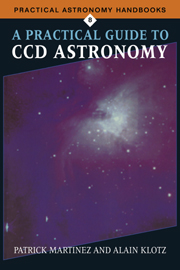Foreword
Published online by Cambridge University Press: 27 October 2009
Summary
Sky aficionados, whether professional astronomers or amateurs, always have two preoccupations. One is aesthetic: they want to capture, in a memorable way, the beauty of the sky. The other is, of course, scientific: they would love to quantify their observations, compare them with others', and verify or discover new effects.
Everyone knows that an astronomical observation uses a complex system. The telescope is an essential element, but is not unique: there is also the choice of site, shielded from light interference and turbulence, the construction and thermal stabilization of the dome, and, of course, the light detector that controls the quality of the final image. It would be more appropriate to speak of the ‘observing system’, whose every link is essential.
In its time, J. Texereau and G. de Vaucouleurs’ famous book L'Astrophotographie d'amateur inspired generations of amateurs when photography was the best way to capture photons. Today, modern light detectors are charge-coupled devices, commonly known as CCDs. If their format does not reach that of a photographic plate, still unequaled in the number of pixels it offers, their sensitivity is several dozen times better. And since we all know that the time needed to reach a given signal-to-noise ratio (which is directly linked to the possibility of detecting a possible astronomical source) varies as the inverse square of the sensitivity, it is easy to understand the incredible leap forward CCDs will enable observers to make.
- Type
- Chapter
- Information
- A Practical Guide to CCD Astronomy , pp. xiii - xviPublisher: Cambridge University PressPrint publication year: 1997

